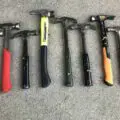Power Tools
Guide & Reviews – How to use a Circular Saw
Let’s be honest: using a circular saw can be incredibly intimidating. Besides, circular saws are daunting, thanks to the huge blade with multiple teeth under incredibly high speed.
A few years back, when I was undertaking my woodworking classes. I picked up a circular saw for the first time to make a few cuts, and it was really scary. However, with time, I have become some sort of circular saw expert, which is why I decided to write this guide.
A circular saw is one of the most important woodworking power tools a woodworker must have. For this reason, it is vital to know how to use it.
Here is my easy-to-understand multi-step guide on how to use a circular saw:
Step One: Know Your Circular Saw
Circular saws come in different sizes and shapes, which is why it’s important to get acquainted with it.
While using a circular saw, you will hold it at the rear and front grips and utilize the trigger on the back grip to control the blade’s movement. Besides construction wood and other lumber types, you can also utilize a circular saw to cut sheet metal and other light metals.
Step Two: Safety
Considering this is a high-performance tool with a sharp revolving blade, it is important to prioritize safety. First, make sure you wear gloves to keep your hands from getting cut by the blade and goggles for eye protection. What’s more, if you will be working for a long time, consider investing in ear muffs and a dust mask.
Step Three: Measure and then Mark the Workpiece Where You Want to Make the Cuts
Take a ruler and a pencil, marker, or pen and draw a straight line everywhere you want to make cuts. These lines will help you guide the blade through making the cuts; therefore, ensure you make them bold enough to see clearly.
Step Four: Position Your material on the Saw Table
Place your workpiece on a sawhorse and ensure it is adequately supported and isn’t resting atop any hurdles. This way, you can be sure to make straight cuts.
Avoid positioning your workpiece atop a table, floor, or bench. This could result in some serious damage to both the bench, table, or floor and your circular saw’s blade.
The market is flooded with sawhorses of different sizes so you can find one at your local home improvement store or hardware.
Step Five: Utilize the Central Lever to Position the Blade to the Cutting Depth You’d Like to Achieve
Tug the shoe lever in the middle of the pair of handles completely to unfasten the baseplate and let it move unrestrictedly. Next, position the baseplate against the workpiece and adjust the blade till it halts or is merely beneath the workpiece.
That said, set the blade about ¼ to 1/8 inches beneath the workpiece’s bottom. If you set it deeper than this, you will force the circular saw to work harder than usual and leave some teeth idle, which is hazardous.
Step Six: Modify the Pivot Scale to Tilt the Blade for Angled Cuts
Turn the tiny knob at the front anti-clockwise to expose the scale close to the blade. Glide the scale to the angle you’d like. Usually, it is one of the preset angles on the frame, though you can halt at a different angle in between for custom cuts. Once you mark the angle, twist it clockwise to hold the scale in place.
Ensure the locking knob is locked in before switching on the circular saw; if not, the scale can shift when the blade starts cutting.
Step Seven: Place the Base Plate line Marked 0 Over the Cut Line Marked on Your Workpiece
On the baseplate’s front, you’ll find a tiny knob with a bold line. The line on the left is marked 0, which corresponds to the blade’s placement when it’s positioned at 900 and is supposed to be utilized when making typical cuts.
The line on the right marked 45, is perfect for making angled cuts at 450.
On top of that, the glide-like attachment will keep the circular saw straight to facilitate long, straight, and accurate cuts.
Step Eight: Activate the Circular Saw Blade
Pull the trigger at the back handle to activate the blade. On the other hand, some models can feature an extra safety trigger close to the circular saw’s top, and you’ll have to press it for the circular saw to start once you pull the back grip trigger.
The moment you pull the trigger, the blade will start spinning, though it would be best to wait until it reaches maximum speed to make your cuts.
With that in mind, make sure you check the measurements and align the baseplate correctly before you start cutting.
Step Nine: Gradually Push the Saw Along the Workpiece’s Surface.
Use your hands to move the saw straight along the cut line, and ensure the baseplate’s right is properly aligned with the cut line you made in step three. It would be best to avoid forcefully pushing the saw along the workpiece. Move it at a natural speed for the best results.
On some circular saws, the blade guard automatically retracts as you motion the saw forward and lowers once more when you lift it from the workpiece. Moreover, you can manually pull it back to create a clear-cutting line when making irregular or beveled cuts.
Step Ten: Let Go of the Trigger to Stop the Saw Blade
The moment you finish cutting, you should let go of the trigger to halt the blade. To stop possible mishaps, keep your finger away from the switch as you double-check the work or mark your nest cut.
Step Eleven: Disconnect the Circular Saw from the Power Outlet
This is the final step. When you are done using your circular saw, disconnect it from the power outlet. Check to make sure the blade guard is in its rightful position. Next, pull the plug from the wall outlet, wrap the cable properly, and store the saw safely until the next time!
Why You Should Trust Us
At Woodworking Tool Guide, we know one size doesn’t fit all! We cater to every woodworker, from beginner to pro, with insights and recommendations tailored to your skill level, project needs, and budget. We take the guesswork out of choosing the right tools, whether you’re tackling your first crafting a masterpiece for the ages. So grab your chisel, join our community, and let’s build something amazing together!
Woodworking Tool Guide wasn’t just born, it sprouted from a seed of passion for the craft. What started as a joyful exploration blossomed into a trusted online haven for fellow enthusiasts like you. We pour our love into meticulously chosen review selections, meticulous hands-on testing, and lab-backed insights, all to empower you with reliable, comprehensive information you can build on. So, grab your tools, trust our guidance, and let’s build something beautiful together!
Passion-Driven Expertise
Our journey started with a shared love for woodworking. The team behind the Woodworking Tool Guide is comprised of individuals who are not just writers but passionate woodworkers themselves. This shared enthusiasm ensures that our content is crafted with a deep understanding of the craft and an authentic appreciation for quality tools.
Top Tool Guides Online
Woodworking Tool Guide has rapidly ascended to become one of the premier online destinations for tool guidance. Our commitment to excellence and the accuracy of our information has positioned us as a reliable source for both beginners and seasoned woodworkers seeking trustworthy advice on the best tools for their projects.
User-Centric Approach
Our content caters to every woodworker, from rookies just starting out to seasoned pros tackling intricate projects. We tailor our insights and recommendations to your skill level, project needs, and budget, ensuring you find the perfect tools to match your unique woodworking journey. So step into your workshop, grab your tool belt, and let Woodworking Tool Guide be your trusted companion as you craft your masterpieces.
Continuous Support and Innovation
Woodworking is an ever-evolving craft, and so is our commitment to supporting you. We are dedicated to bringing you the latest information on woodworking tools, techniques, and trends. Our team is actively working to expand our content and bring you more valuable insights, ensuring that you stay well-informed in your woodworking adventure.
Hands-On Experience
Ditch the endless research rabbit hole! At Woodworking Tool Guide, we believe in actionable advice, not armchair analysis. We get our hands dirty, putting every tool through its paces in real-world woodworking scenarios. Whether it’s the precision of a table saw, the versatility of a router, or the tactile satisfaction of a handplane, we test for performance, durability, and user-friendliness. No more sifting through dry specs – we deliver practical insights you can trust to transform your woodworking dreams into reality.
Woodworking Tool Guide isn’t just a review site, it’s your trusted companion on the sawdust-filled path to woodworking mastery. Our expert team, led by veteran David Jones, meticulously tests and explains tools in terms you understand. We cut through the jargon, bias, and confusion with real-world insights and honest evaluations. Join our passionate community, where decades of experience, cutting-edge knowledge, and shared love for the craft come together to guide you every step of the way. So grab your chisel, buckle up, and let’s embark on this exciting woodworking adventure, together!
Conclusion
Well, there you have it: a detailed step-by-step guide on how to use a circular saw. On top of that, I would recommend getting a quality blade for your machine. While some circular saws come with blades, some don’t, so make sure to choose one that’s compatible with your saw and a durable, affordable, and high-performance blade.





